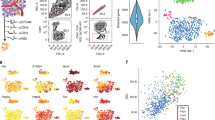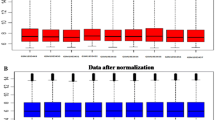Abstract
Background
Breast cancer is characterized by malignant transformation of epithelial cells, but stromal cells also play an important role in tumorigenesis. While tumor-derived fibroblasts display unique phenotypic properties, it is unclear whether they also represent are a specific subpopulation.
Materials and Methods
Stromal fibroblasts deriving from malignant tissue of 10 women with invasive breast cancer, and from normal breast tissue of 10 women with benign breast disorders, were subjected to differential complementary DNA Microarray Analysis by using a 2,400 gene cDNA array. Individual gene expression pattern were confirmed by RT-PCR.
Results
In a cDNA array that allows to analyze the differential gene expression of more than 2,400 genes, the mRNA expression of 135 genes were increased more than 2 fold in fibroblasts from malignant breast tumors. The majority of these genes encode tumor-promoting cytokines, transcription factors and cell-matrix associated proteins. The mRNA expression of 110 genes decreased to less than 0.5 fold. The remaining 2,155 genes were not significantly altered. RT-PCR performed on individual biopsies from breast cancer and normal breast tissues confirmed the validity of the pooled gene expression signature.
Conclusion
Breast cancer-derived stromal fibroblasts show a distinctive gene expression pattern that differentiates them from normal breast stroma. Our observation of increased expression of tumor promotion-associated genes even in the absence of adjacent malignant epithelium suggests that tumor stroma is comprised of a fibroblastic subpopulation that provides for a microenvironment which supports tumor growth and invasion.



Similar content being viewed by others
References
Wiseman BS, Werb Z (2002) Stromal effects on mammary gland development and breast cancer. Science 296:1046–1049
Bonnette SG, Hadsell SL (2001) Targeted disruption of the IGF-I receptor gene decreases cellular proliferation in mammary terminal end buds. Endocrinology 142:4937–4945
Renehan AG, Zwahlen M, Minder C, O’Dwyer ST, Shalet SM, Egger M (2004) Insulin-like growth factor (IGF)-I, IGF binding protein-3, and cancer risk: systematic review and meta-regression analysis. Lancet 363:1346–1353
Kucab JE, Dunn SE (2003) Role of IGF-1R in mediating breast cancer invasion and metastasis. Breast Dis 17:41–47
Derynck R, Akhurst JR, Balmain A (2001) TGF-beta signaling in tumor suppression and cancer progression. Nat Genet 29:117–129
Kaklamani V, Pasche B (2005) Transforming growth factor beta and breast cancer. Cancer Treat Res 126:129–156
Duffy MJ, Maguire TM, Hill A, McDermott E, O’Higgins N (2000) Metalloproteinases: role in breast carcinogenesis, invasion and metastasis. Breast Cancer Res 2(4):252–257
Mercurio AM, Bachelder RE, Chung J, O’Connor KL, Rabinovitz I, Shaw LM, Tani T (2001) Integrin laminin receptors and breast carcinoma progression. J Mammary Gland Biol Neoplasia 6(3):299–309
Torricelli C, Fortino V, Capurro E, Sacchi G, Ponzo P, Pacini A, Muscettola M, Maioli E (2006) Role of PTHrp and PTHrp-engaged pathways in MCF-7 cells migration/invasion. Matrix Biol 25(2):104–111
Barcellos-Hoff MH, Medina D (2005) New highlights on stroma-epithelial interactions in breast cancer. Breast Cancer Res 7(1):33–36
Kim JB, Stein R, O’Hare MJ (2005) Tumour-stromal interactions in breast cancer: the role of stroma in tumourigenesis. Tumour Biol 26(4):173–185
Singer C, Rasmussen A, Smith HS, Lippman ME, Lynch HT, Cullen KJ (1995) Malignant breast epithelium selects for insulin-like growth factor II expression in breast stroma: evidence for paracrine function. Cancer Res 55(11):2448–2454
Grey AM, Schor AM, Rushton G, Ellis I, Schor SL (1989) Purification of the migration stimulating factor produced by fetal and breast cancer patient fibroblasts.Proc. Natl Acad Sci U S A 86:2438–2442
Zrihan-Licht S, Lim J, Keydar I, Sliwkowski MX, Groopman JE, Avraham H (1997) Association of csk-homologous kinase (CHK) (formerly MATK) with HER-2/ErbB-2 in breast cancer cells. J Biol Chem 272(3):1856–1863
Gouon-Evans V, Rothenberg ME, Pollard JW (2000) Postnatal mammary gland development requires macrophages and eosinophils. Development 127(11):2269–2282
Pollard JW, Hennighausen L (1994) Colony stimulating factor 1 is required for mammary gland development during pregnancy. Proc Natl Acad Sci U S A 91(20):9312–9316
Lin EY, Nguyen AV, Russell RG, Pollard JW (2001) Colony-stimulating factor 1 promotes progression of mammary tumors to malignancy. J Exp Med 193(6):727–740
Castiglioni T, Merino MJ, Elsner B, Lah TT, Sloane BF, Emmert-Buck MR (1994) Immunohistochemical analysis of cathepsins D, B, and L in human breast cancer. Hum Pathol 25(9):857–862
Harbeck N, Alt U, Berger U, Krüger A, Thomssen C, Jänicke F, Höfler H, Kates RE, Schmitt M (2001) Prognostic impact of proteolytic factors (urokinase-type plasminogen activator, plasminogen activator inhibitor 1, and cathepsins B, D, and L) in primary breast cancer reflects effects of adjuvant systemic therapy. Clin Cancer Res 7:2757–2764
Cook AC, Tuck AB, McCarthy S, Turner JG, Irby RB, Bloom GC, Yeatman TJ, Chambers AF (2005) Osteopontin induces multiple changes in gene expression that reflect the six “hallmarks of cancer” in a model of breast cancer progression. Mol Carcinog 43(4):225–236
Zohar R, Suzuki N, Suzuki K, Arora P, Glogauer M, McCulloch CA, Sodek J (2000) Intracellular osteopontin is an integral component of the CD44-ERM complex involved in cell migration. J Cell Physiol 184(1):118–130
Das R, Mahabeleshwar GH, Kundu GC (2003) Osteopontin stimulates cell motility and nuclear factor kappaB-mediated secretion of urokinase type plasminogen activator through phosphatidylinositol 3-kinase/Akt signaling pathways in breast cancer cells. J Biol Chem 278(31):28593–28606
Bramwell VH, Doig GS, Tuck AB, Wilson SM, Tonkin KS, Tomiak A, Perera F, Vandenberg TA, Chambers AF (2006) Serial plasma osteopontin levels have prognostic value in metastatic breast cancer. Clin Cancer Res 12(11 Pt 1):3337–3343
Wakefield LM, Piek E, Bottinger EP (2001) TGF-beta signaling in mammary gland development and tumorigenesis. J Mammary Gland Biol Neoplasia 6(1):67–82
Muraoka-Cook RS, Dumont N, Arteaga CL (2005) Dual role of transforming growth factor beta in mammary tumorigenesis and metastatic progression. Clin Cancer Res 11(2 Pt 2):937s–943s
Nieman MT, Prudoff RS, Johnson KR, Wheelock MJ (1999) N-cadherin promotes motility in human breast cancer cells regardless of their E-cadherin expression. J Cell Biol 147(3):631–644
Pishvaian MJ, Feltes CM, Thompson P, Bussemakers MJ, Schalken JA, Byers SW (1999) Cadherin-11 is expressed in invasive breast cancer cell lines. Cancer Res 59(4):947–952
Acknowledgements
This study was supported by a grant from the Foundation for Breast Health, by a grant from the Austrian Society for Endocrinological Oncology, by a grant from Amgen Inc. and Ebewe Inc., and by a grant from Medizinisch-Wissenschaftlicher Fonds des Bürgermeisters der Bundeshauptstadt Wien.
Author information
Authors and Affiliations
Corresponding author
Rights and permissions
About this article
Cite this article
Singer, C.F., Gschwantler-Kaulich, D., Fink-Retter, A. et al. Differential gene expression profile in breast cancer-derived stromal fibroblasts. Breast Cancer Res Treat 110, 273–281 (2008). https://doi.org/10.1007/s10549-007-9725-2
Received:
Accepted:
Published:
Issue Date:
DOI: https://doi.org/10.1007/s10549-007-9725-2




